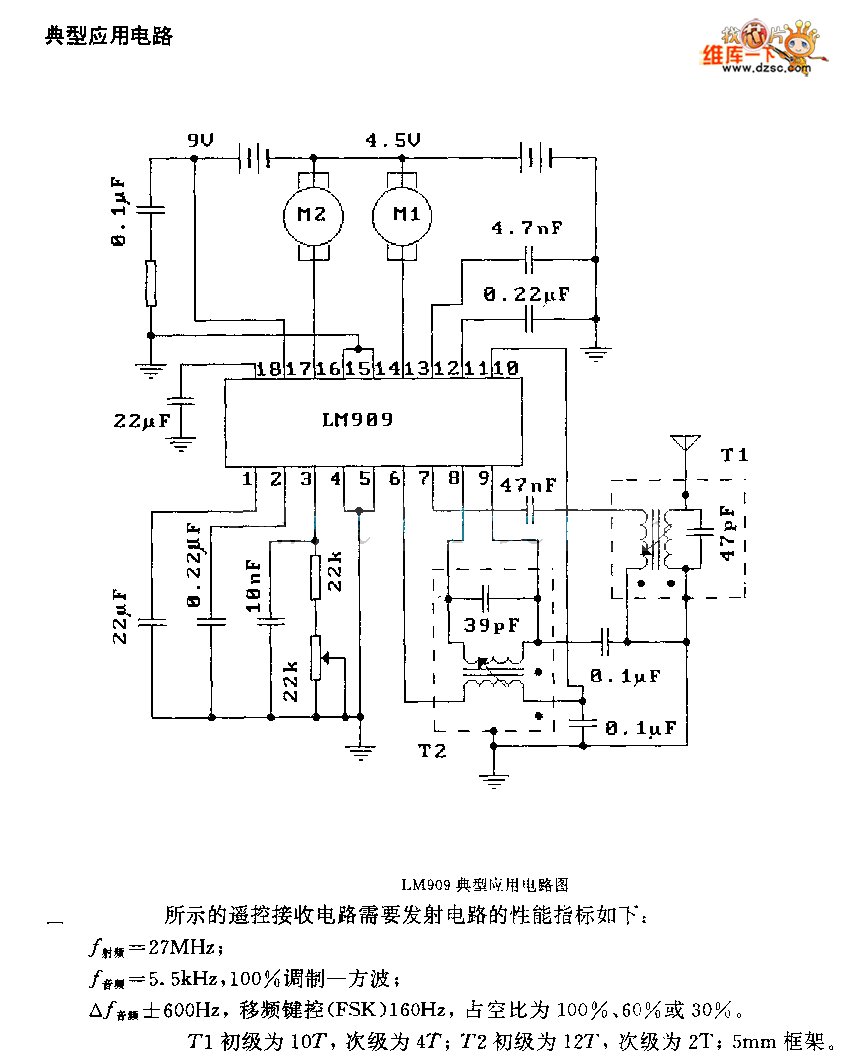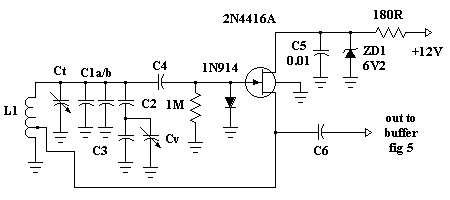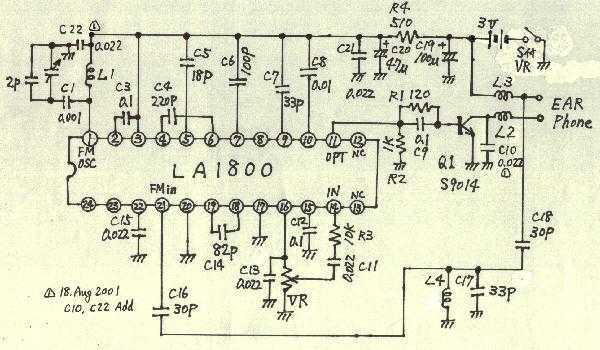
Radio Jammer
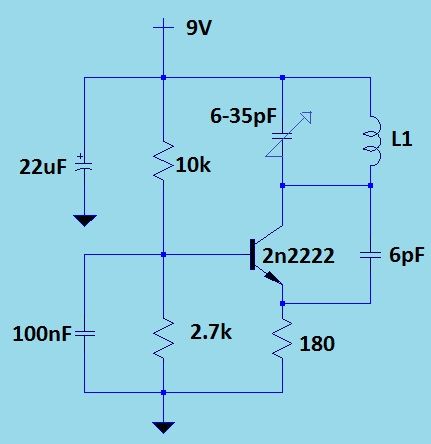
This is not a cell phone jammer. Jamming a cell phone operates on similar principles, but requires a different construction, necessitating a frequency range from 800 MHz to 900 MHz. An operational amplifier and several other components are needed, along with specific formulas. The radio jammer emits an electromagnetic wave at a designated frequency, broadcasting it throughout an area. Radios tuned to this frequency will receive the wave and block other waves transmitted from stations. The oscillator is the core component of the radio jammer, determining the frequency to be jammed. For example, to block a frequency of 100.0 MHz, a 100 MHz oscillator should be used. Oscillators can be identified by their frequency specifications, such as a 97.7 MHz oscillator marked as 97M70000 or a 50 MHz oscillator marked as 50.0000 MHz. The original battery and antenna of a phone may be reused for continuous charging. The choice of oscillator frequency, such as a 125 MHz oscillator, depends on various factors, including power, frequency, harmonics, and carrier signals. Sufficient power at the same frequency or its harmonics can effectively jam a channel. An oscillator can be simply represented by an inductor and capacitor in its basic form. Researching basic oscillator construction, stepper generators, and historical radio jamming techniques could be beneficial. Generally, radio jamming involves generating a signal at the target frequency with higher power and more noise. For instance, to block a voice signal, one could record multiple voices and transmit that as a signal. Although oscillators can be challenging to source, there are circuits available that claim to achieve similar results. However, the legality of using such devices varies by location. The schematic designs are straightforward, but their effectiveness remains uncertain. Testing within a Faraday cage may provide a legal means to experiment. In Australia, sourcing the required oscillators can be difficult, as local electronic stores may not carry them. An increase in battery voltage, such as from 9V to 10.5V, may allow eavesdropping on the channel being jammed. Oscillators may have tolerances, potentially allowing them to operate within a frequency range of ±1 MHz. While it is unlikely that electronic modifications can extend the jamming range, adding a switch to alternate between oscillators of different frequencies could provide more options. Stereos function solely as receivers and cannot transmit, thus cannot be used to block frequencies in the manner described.
To construct a radio jammer, the following components and principles must be considered:
1. **Oscillator Circuit**: The core of the jammer is the oscillator, which generates the desired jamming frequency. This can be built using a combination of inductors and capacitors, commonly in a Colpitts or Hartley configuration. The oscillator's frequency can be adjusted by varying the values of these components or using a variable capacitor.
2. **Amplification Stage**: An operational amplifier (op-amp) may be used to amplify the signal generated by the oscillator. This stage is crucial for ensuring that the jamming signal has sufficient power to effectively block the target frequency.
3. **Antenna**: A suitable antenna must be designed or selected to efficiently transmit the jamming signal. The antenna's dimensions should be appropriate for the frequency being jammed, following the principles of antenna design, such as length and impedance matching.
4. **Power Supply**: A stable power source is essential for the operation of the circuit. The use of the original battery from a phone may provide a convenient method for powering the device, but careful consideration must be given to the voltage and current requirements of the circuit.
5. **Testing and Tuning**: After assembly, the circuit must be tested within a controlled environment, such as a Faraday cage, to prevent unintended interference with other devices. Tuning the oscillator may be necessary to ensure effective jamming of the desired frequency.
6. **Legal Considerations**: It is imperative to acknowledge the legal implications of operating a radio jammer, as unauthorized use can lead to severe penalties. Understanding local regulations and ensuring compliance before testing or deploying such devices is essential.
By adhering to these guidelines, a functional radio jammer can be constructed, but users must remain aware of the ethical and legal ramifications associated with its use.This also Not a Cell phone jammer. Jamming a Cell phone is similar on its principle, but totally a different build, you need a range from 800MHz to 900MHz. You need an OP amp and a few other parts and formulas The Radio Jammer sends out a EM wave at a frequency.
The wave is then broadcast throughout an area. Radios will receive this wave (when tun ed to that frequency) and It will block the other wave that is broadcast from a station. An Oscillator, The heart of the Radio Jammer. The frequency you choose will be the frequency you jam. FM radio is in MegaHertz. Example, If you want to block 100. 0, then use a 100Mh Oscillator. It may be a bit confusing. I have a 97. 7 MHz that says 97M70000 and a 50 MHz that says 50. 0000 MHz. Could you use the original battery for the phone so you can just charge it over and over as well as the original antenna (Im thinkin of going with a 125 oscillator. That depends on power, frequency, harmonics and carrier. There are a number of factors. Overall if you are pumping enough power into the air on the same frequency or on a harmonic of the same frequency it is likely you could jam the channel.
Also for all of you who asked, remember that an oscillator is simply a inductor and capacitor in its more basic form. What I would do is take a look at the construction of basic oscillators, stepper generators and radio jamming during times of war.
For all intents most radio jamming is simply producing a signal on the same frequency that you want to jam at a higher power with more noise. AKA if you are trying to block a voice signal a good way to do it would be to copy several voices on a tape and send that as a signal.
Nice instructables but oscillator is kinda hard to find. I got circuit here claims that can do the same. radio jammer, dont know what is the idea behind in this circuit. Anyone have idea if it is working or it will be working. circuit copied from: I live in a place where it is illegal to use such things. The schematic look really strait forward and simple. I dont know if it would work but I am working on a Faraday cage so I can test such things legally Sorry for my limited info, i am in Australia. The main electronic stores do not supply oscillators of this type. 4 pin. and none of the frequencies I need in my country. Good article. This is pretty strange that increasing the 9v battery by 1. 5v let you eavesdrop on the channel your were blocking. try readjusting slightly and checking out what else happens. Please let us know. Thanks. There is probably some tolerance to each oscillator. I can`t say for certain that it will go from 90-108, but it probably will do +- 1Mhz. I haven`t checked it out in a long time, so I don`t really know if its +-1Mhz or larger. In a short answer, it will block around maybe 98-102. There is no way to make it have a larger area by changing something electronically, at least to my knowledge.
you can add a switch to route the current from the battery to another oscillator of a different frequency to have more than one choice. my family listens to lots of boring stations ; ) would there be anyway to use an old stereo instead of phone so that you`d be able to `tune into` the station you were trying to block instead of just blocking one station.
Stereos are just a receiver, they don`t do any transmitting. I understand what you are getting at, where if you want to block some channel you would just turn a knob to get to the certain frequency, but in order to change the frequency, you would need to change the oscillators frequency, which to my understanding would be to shorten or lengthen the crystal inside (which I don`t think is going to happen). 🔗 External reference
To construct a radio jammer, the following components and principles must be considered:
1. **Oscillator Circuit**: The core of the jammer is the oscillator, which generates the desired jamming frequency. This can be built using a combination of inductors and capacitors, commonly in a Colpitts or Hartley configuration. The oscillator's frequency can be adjusted by varying the values of these components or using a variable capacitor.
2. **Amplification Stage**: An operational amplifier (op-amp) may be used to amplify the signal generated by the oscillator. This stage is crucial for ensuring that the jamming signal has sufficient power to effectively block the target frequency.
3. **Antenna**: A suitable antenna must be designed or selected to efficiently transmit the jamming signal. The antenna's dimensions should be appropriate for the frequency being jammed, following the principles of antenna design, such as length and impedance matching.
4. **Power Supply**: A stable power source is essential for the operation of the circuit. The use of the original battery from a phone may provide a convenient method for powering the device, but careful consideration must be given to the voltage and current requirements of the circuit.
5. **Testing and Tuning**: After assembly, the circuit must be tested within a controlled environment, such as a Faraday cage, to prevent unintended interference with other devices. Tuning the oscillator may be necessary to ensure effective jamming of the desired frequency.
6. **Legal Considerations**: It is imperative to acknowledge the legal implications of operating a radio jammer, as unauthorized use can lead to severe penalties. Understanding local regulations and ensuring compliance before testing or deploying such devices is essential.
By adhering to these guidelines, a functional radio jammer can be constructed, but users must remain aware of the ethical and legal ramifications associated with its use.This also Not a Cell phone jammer. Jamming a Cell phone is similar on its principle, but totally a different build, you need a range from 800MHz to 900MHz. You need an OP amp and a few other parts and formulas The Radio Jammer sends out a EM wave at a frequency.
The wave is then broadcast throughout an area. Radios will receive this wave (when tun ed to that frequency) and It will block the other wave that is broadcast from a station. An Oscillator, The heart of the Radio Jammer. The frequency you choose will be the frequency you jam. FM radio is in MegaHertz. Example, If you want to block 100. 0, then use a 100Mh Oscillator. It may be a bit confusing. I have a 97. 7 MHz that says 97M70000 and a 50 MHz that says 50. 0000 MHz. Could you use the original battery for the phone so you can just charge it over and over as well as the original antenna (Im thinkin of going with a 125 oscillator. That depends on power, frequency, harmonics and carrier. There are a number of factors. Overall if you are pumping enough power into the air on the same frequency or on a harmonic of the same frequency it is likely you could jam the channel.
Also for all of you who asked, remember that an oscillator is simply a inductor and capacitor in its more basic form. What I would do is take a look at the construction of basic oscillators, stepper generators and radio jamming during times of war.
For all intents most radio jamming is simply producing a signal on the same frequency that you want to jam at a higher power with more noise. AKA if you are trying to block a voice signal a good way to do it would be to copy several voices on a tape and send that as a signal.
Nice instructables but oscillator is kinda hard to find. I got circuit here claims that can do the same. radio jammer, dont know what is the idea behind in this circuit. Anyone have idea if it is working or it will be working. circuit copied from: I live in a place where it is illegal to use such things. The schematic look really strait forward and simple. I dont know if it would work but I am working on a Faraday cage so I can test such things legally Sorry for my limited info, i am in Australia. The main electronic stores do not supply oscillators of this type. 4 pin. and none of the frequencies I need in my country. Good article. This is pretty strange that increasing the 9v battery by 1. 5v let you eavesdrop on the channel your were blocking. try readjusting slightly and checking out what else happens. Please let us know. Thanks. There is probably some tolerance to each oscillator. I can`t say for certain that it will go from 90-108, but it probably will do +- 1Mhz. I haven`t checked it out in a long time, so I don`t really know if its +-1Mhz or larger. In a short answer, it will block around maybe 98-102. There is no way to make it have a larger area by changing something electronically, at least to my knowledge.
you can add a switch to route the current from the battery to another oscillator of a different frequency to have more than one choice. my family listens to lots of boring stations ; ) would there be anyway to use an old stereo instead of phone so that you`d be able to `tune into` the station you were trying to block instead of just blocking one station.
Stereos are just a receiver, they don`t do any transmitting. I understand what you are getting at, where if you want to block some channel you would just turn a knob to get to the certain frequency, but in order to change the frequency, you would need to change the oscillators frequency, which to my understanding would be to shorten or lengthen the crystal inside (which I don`t think is going to happen). 🔗 External reference
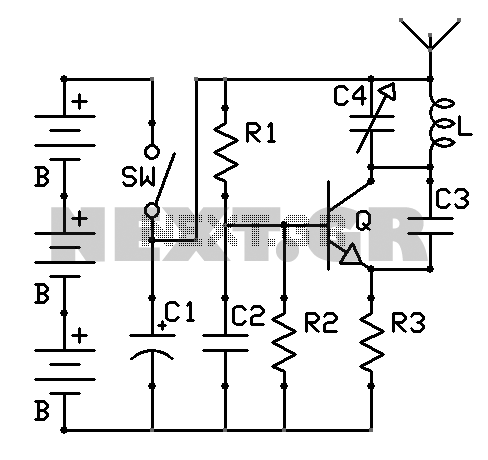
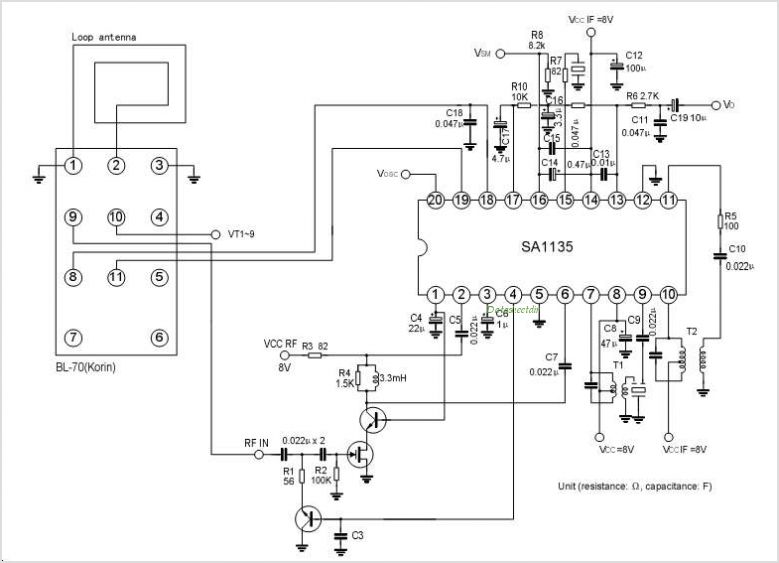
C0QBmk~%24(KGrHqIOKkIEq4M%2Bu,)1BK2zHH580Q~~_35.gif)
